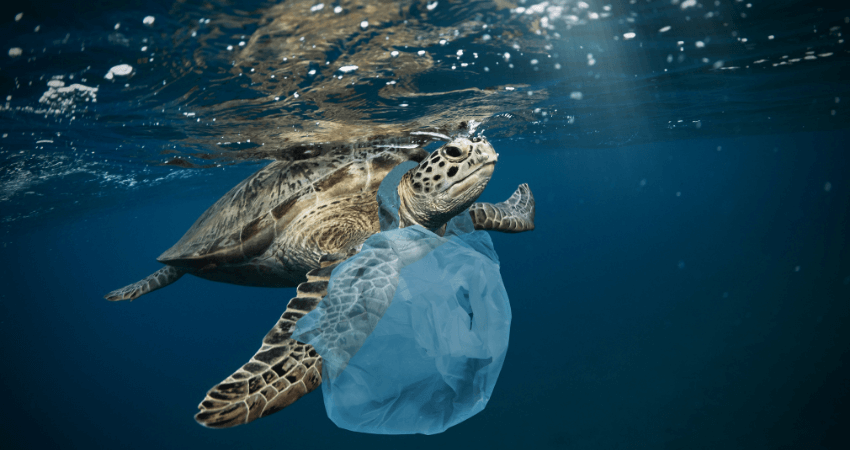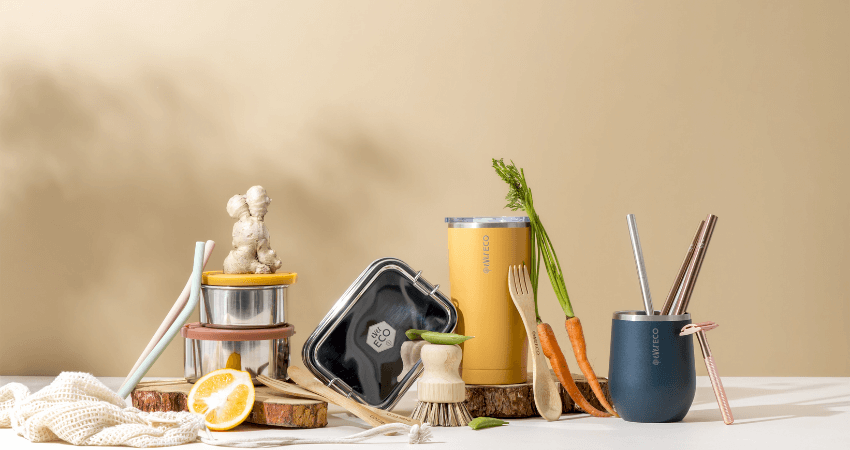Plastic Free July is a global movement that helps you (and millions of others) do their bit to help solve the plastic pollution crisis. From information to handy lifestyle tips, this guide will help kickstart your month of reducing plastic waste.
Put simply, Plastic Free July is a challenge to cut single-use plastics from your life – you can pledge to take the challenge for a day, a week, the whole month of July or from now on. Outside of the challenge, Plastic Free July is a collective of people that share tips and advice on how to reduce plastic waste in all areas of our lives. With a focus on education, real stories and experiences, Plastic Free July motivates us to do what we can to protect our planet from the dangers of plastic pollution. If you’re already keen to challenge yourself and cut out plastics from your life, you can register here or watch the video below to learn more about the challenge.
Wondering: what is plastic pollution? Plastic pollution is the build-up of disposable plastic products in our environment and it’s quickly become one of the world’s most pressing environmental issues. Plastic pollution is especially significant in developing countries in Asia and Africa where waste-disposal systems are easily overwhelmed with the level of plastic. That said, countries across the world have difficulty disposing of plastics, especially as this material can take hundreds of years to break down.
Plastic: the numbers
Plastic is convenient. That’s the main reason it exists. But there’s a price to pay for this convenience. On average, Australians use 130 kg of plastic per person each year. And in the year between 2017 and 2018, a total of 3.4 million tonnes of plastics were consumed in Australia. Although Australia is known for many amazing things, it’s also one of the most wasteful countries in the world and our waste levels grow at twice the rate of our population.
Plastic is made from fossil fuel
Many people aren’t aware that over 99 per cent of plastic is made from chemicals sourced from fossil fuels. Extracting and using fossil fuels is a big contributor to climate change and the process can pollute local waterways, soil and air. So, plastic isn’t just harmful when it’s plastic – the process of making plastic is dangerous both to the planet and its people, especially those that live close to oil extraction rigs and plastic-making plants.
Plastic doesn’t break down easily and usually isn’t recycled
Plastic doesn’t decompose. Meaning, most of the plastic that’s ever been made is still in our environment in one form or another. Plastic does of course break down over time but we’re talking within 10 years at best, more than 1,000 at worst. Plastic often breaks down into microplastics – little fragments of plastic – that can get into the water, food and poison wildlife. Wondering where recycling fits into all this? Unfortunately, only about nine per cent of Australians’ plastic is recycled each year. Many plastics can’t easily be recycled due to their complex shapes, colours and blends of different plastic. And so, they’re often thrown into landfill instead.
Plastic harms our natural wildlife and environment
Every year, about eight million tonnes of plastic winds up in our oceans. Most of the plastic in the oceans flows from land and travels across oceans from different parts of the world. millions of animals each year fall victim to the plastic pollution crisis. Most of the deaths are the result of entanglement or starvation – from being strangled in abandoned fishing gear to discarded six-pack rings. Microplastics have also been found in the bellies of more than 100 aquatic species.

1. Learn your recycling rules
One of the best ways to help reduce plastic waste pollution is to know how best to dispose of your plastic waste. Recycling differs in each town, city and country. But a good place to start is learning the recycling symbols on packaging. Sustainability Victoria has a great guide to help Victorians understand recycling symbols on their favourite products.
2. Process your non recyclable plastics properly with TerraCycle®
You’ll find that many of your plastics can’t easily be recycled in your regular, community recycling bin. Soft plastics are a prime example of this. Luckily, in Australia, the leading soft plastics recycler RedCycle now has drop-off points at major supermarkets that you can access to stop your soft plastics from going to landfill. Beauty, skincare and personal care packaging are notorious for not being recyclable. TerraCycle® is a social enterprise that recycles these difficult empty plastics and turns them into new products like roads and kids playframes. Sassy Organics offers its recycling program via TerraCycle®. So, you can send us your personal care empties and we’ll give you a $10 store credit in return. Learn more about how you can properly dispose of your product empties and earn rewards here.
3. Shop with plastic free, or low waste businesses
Another great way to get started with your plastic-free journey is to support businesses that try to reduce plastic use and waste. Many local or small retailers are cutting plastic from their packaging and product lines. At Sassy Organics, we’re proud to deliver our parcels entirely plastic-free. From the box right down to the tape, no plastic is used to get your order safely to your door. You can learn more about our commitment to the planet here.

4. Replace single use plastics with reusable items
One of the simplest and most effective ways of cutting single-use plastic from your life is to replace it with reusable, plastic-free swaps. At Sassy Organics, we have an entire plastic-free range that makes it easy to stop using plastic and switch to stylish and sustainable alternatives. When it comes to eating and drinking, it’s essential to have a reusable coffee cup and reusable straws to hand. Some of our favourite food and drinkware materials are glass, stainless steel and bamboo. One of the main reasons we use single-use plastics while on the go is that there’s usually no other choice. That’s why I like to always keep my reusable cutlery set in my handbag, so I know I’ll never get caught out. When it comes to personal care and beauty, plastic can feel unavoidable. Solid beauty products are a great option for reducing your plastic waste while still nourishing your skin and hair. Another tip for making your skincare routine low waste or plastic-free is investing in some reusable makeup remover pads. These can eliminate the need for plastic-packaged makeup removers altogether and are so good for your skin.
5. Get involved in a clean up
While it’s so important to reduce your plastic consumption and waste, there is still so much plastic pollution already out there. Taking part in a local clean-up is a great way to prevent plastic from ending up in natural waterways and harming our wildlife. I took part in the Clean Up Australia day earlier this year and had the best time. Not only do you do something amazing for your community, but you get to connect with lots of like-minded locals – win, win!
Plastic Free July is a great time to reflect on ways you can reduce plastic from your life but that doesn’t mean you have to take the challenge for the whole month of July (although that’s great if you do!). Taking part could be as simple as saying no to plastic cutlery or straws – whatever fits your life. And while it’s important we each do our bit, we should always remember that things like plastic pollution are big problems that require a lot of high-level change. We can’t tackle this sort of thing alone, but together we can make a real difference!
Sources
National Geographic | WWF | Environment.Gov | ABC’s War on Waste | CIEL
RECOMMENDED PRODUCTS